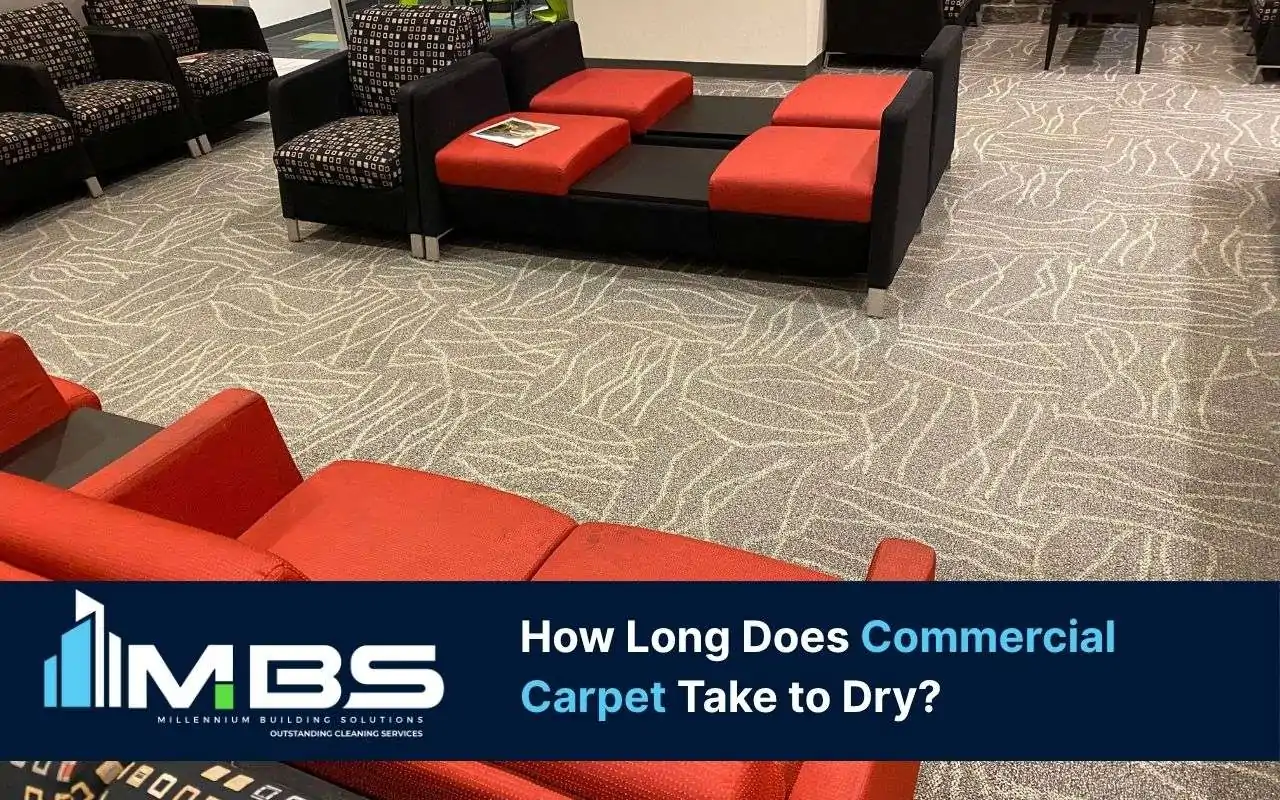
When scheduling professional cleaning for your business, understanding commercial carpet drying time is crucial. Picture a freshly cleaned office carpet using hot water extraction—it looks spotless but feels damp. Knowing the factors that affect drying helps minimize downtime and maintain operations smoothly. From carpet fiber type to indoor conditions, each element impacts how quickly your workspace is ready. Using air movers and dehumidifiers can drastically shorten drying time, protecting carpets from mold and odor. This guide explores the key variables influencing commercial carpet drying time and offers tips to make your drying process faster and more efficient. For more details about our professional floor care solutions, visit our services page.
Types of Commercial Carpet Fibers and Their Drying Time
Carpet fibers determine how fast moisture escapes after cleaning. Nylon, polyester, olefin, and wool each react differently to water. Nylon dries faster, while wool retains moisture longer because of its density. Polyester and olefin resist water and dry moderately quickly. The construction style—looped or twisted—also influences airflow and evaporation rates.
- Nylon dries within 6–12 hours under optimal conditions.
- Polyester and olefin take about 8–14 hours.
- Wool may need 12–24 hours to dry completely.
By understanding these characteristics, cleaning teams can set realistic timelines. Proper planning prevents mold growth and ensures safe, dry floors. A clear knowledge of commercial carpet drying time enhances scheduling efficiency for businesses of all sizes.
Influence of Carpet Thickness on Drying Duration
Carpet thickness directly affects evaporation speed. Thicker piles hold more moisture, while low-pile carpets release it faster. Dense foam backing or heavy padding may trap moisture and delay drying. In contrast, open-weave materials promote airflow and shorten the commercial carpet drying time.
- Thin carpets: dry in 6–8 hours on average.
- Thicker piles: may require 10–16 hours.
- Rubber-backed carpets: often need extra ventilation time.
Factoring in thickness before cleaning helps avoid premature foot traffic, which could press water deeper into fibers. Proper airflow and spacing during drying ensure consistent results across the office.
Impact of Cleaning Method on Carpet Drying Speed
Cleaning methods significantly alter drying durations. Hot water extraction, though thorough, introduces more water into the fibers. Low-moisture methods like encapsulation or dry compound cleaning use less water and reduce drying periods considerably. The key is balancing deep cleaning with manageable commercial carpet drying time.
- Hot water extraction: 12–24 hours drying.
- Encapsulation cleaning: 1–3 hours drying.
- Dry compound method: minimal downtime for commercial spaces.
Choosing the right technique ensures cleanliness while keeping your office accessible sooner. Learn more about professional cleaning methods through our contact page.
Importance of Indoor Climate Conditions for Drying
Temperature, humidity, and airflow determine drying efficiency. Warm, ventilated environments accelerate evaporation, while cold or humid areas slow it down. Ideally, indoor temperatures between 68°F and 75°F and humidity below 50% create the best conditions. Proper HVAC use and open air circulation help maintain optimal commercial carpet drying time.
Utilizing Air Movers to Accelerate Drying Process
Air movers push large volumes of air across carpet surfaces, enhancing evaporation. Positioning several units evenly around the space improves coverage. This technique can reduce drying time by half, making it ideal for high-traffic commercial environments.
- Use 3–4 air movers per 500 square feet.
- Direct airflow horizontally for best results.
- Combine with dehumidifiers for faster drying.
Strategic placement of air movers shortens commercial carpet drying time and ensures uniform dryness throughout the office.
Role of Dehumidifiers in Commercial Carpet Drying
Dehumidifiers remove moisture from the air, preventing reabsorption into the carpet. Combined with air movers, they create an ideal balance of airflow and dryness. Refrigerant models work well in warm climates, while desiccant types perform better in cooler, low-humidity environments. Maintaining humidity below 50% greatly reduces commercial carpet drying time and prevents mold formation.
Avoiding Common Mistakes that Prolong Drying Time
Overusing cleaning solutions or using weak extraction equipment can delay drying. Failing to vacuum before cleaning also causes unnecessary moisture retention. Moreover, poor air mover positioning or insufficient ventilation slows down results. Correcting these mistakes ensures faster restoration and longer carpet life. Avoiding these errors not only saves time but also protects your investment.
Professional Tips for Faster Commercial Carpet Drying
Scheduling cleanings during off-hours enhances airflow and minimizes disruptions. Removing furniture helps airflow reach every surface. Monitoring humidity and temperature ensures consistent results. A mix of hot water extraction and low-moisture finishing reduces residual dampness while ensuring deep cleanliness.
- Plan cleaning when offices are empty.
- Use digital humidity meters to track conditions.
- Combine airflow tools for balanced drying.
Following these steps ensures an efficient and reliable commercial carpet drying time every session. If you’re interested in professional carpet care services, explore our services page for expert help.
Frequently Asked Questions
How long does a commercial carpet usually take to dry?
Depending on cleaning methods and airflow, drying can range from 4 to 24 hours. Using air movers reduces it significantly.
What factors most affect commercial carpet drying?
Fiber type, humidity, temperature, and airflow are key. Controlling these variables helps reduce overall commercial carpet drying time.
Can carpets dry faster in winter?
Yes, if indoor heating and ventilation are used effectively. Warm air promotes quicker evaporation and balanced drying.
Are dehumidifiers necessary for every job?
They’re not always essential, but they greatly speed up drying and prevent moisture returning to fibers in humid conditions.
How do I know if carpets are completely dry?
Check moisture with a meter or touch test. When the carpet feels cool but not damp, it’s ready for normal use.
Ensuring Efficient Commercial Carpet Drying for Business Continuity
Efficient commercial carpet drying time depends on preparation, airflow, and equipment. Using air movers, dehumidifiers, and proper cleaning techniques reduces downtime. Consistent monitoring and climate control help maintain safety and cleanliness. Keep your carpets in excellent condition and your business running smoothly. Contact our experts via the contact page to schedule your next professional service today.
